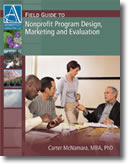© Copyright Carter McNamara, MBA, PhD, Authenticity Consulting, LLC.
Sections of This Topic Include
Basic Overview of Theory of Change
How to Develop a Theory of Change
Example of a Theory of Change (for Community Collaboration)
Examples of the Theory of Change
Special Topics About Theory of Change
Training and Resources About the Theory of Change
Also, consider
Guidelines
and Framework for Developing Logic Models
Related Library Topics
Basic Overview of Theory of Change
A system, such as a program, product, or program has a recurring set of activities,
including:
- Inputs to the system, such as curriculum materials, funding, and expertise
- Processes that occur to the inputs, such as training, facilitations and
coaching - Outputs from the processes, such as the number of students trained
- Changes in external resources, such as new knowledge, skills, and abilities
among the students
Logic models are often used to depict this flow of activities. However, what
is missing from the logic models are the depiction and explanation of how those
activities affect — or are supposed to affect — each other. The theory of
change is extremely useful in that regard.
A logic model can clearly depict the order of the phases in a systematic program,
such as the training program above. However, it does not explain how those phases
are closely integrated to produce the desired outcomes from the program. For
example, the logic model does not explain the assumptions that program designers
make when they conclude that certain processes will produce certain outputs
and outcomes.
The theory of change in the program explains those assumptions. It explains
the assumed causes and effects that program designers can study in order to
understand why a program works or does not work. The theory of change can also
explain what others must do to duplicate or improve similar programs.
The theory of change applies to almost any kind of designed system, including products,
services, and programs. Thus, the concept can be extremely useful to any kind
of organization or internal unit in the organization.
Theory
of Change vs Logical Framework – what’s the difference?
Differences
Between the Theory of Change and the Logic Model
How to Develop a Theory of Change
Theory
of Change – When to Use
Theory
of Change (a how-to)
Theory
of Change (another how-to)
How
to Build a Theory of Change
Example of a Theory of Change (for a Community
Collaboration)
The following example is based on this logic model for a community collaboration of several nonprofit organizations working together to accomplish a common overall change in the community. The reader
is encouraged to print out that one-page model as he or she reads the following
theory of change. During the example collaboration, the lead organization supports
the organizational development of each partnering organization with assessments,
training, coaching, and peer learning.
Information in a theory of change is sometimes described in a reverse order
of the parts of the logic model because the primary focus is on – and
starts with – the expected outcomes.
7. Community-level, long-term outcomes:
- certain social issues will be resolved for a certain group of clients in
certain geographic area(s)
Program Activities:
These desired outcomes are to reduce the occurrence of gang activity, youth
violence, and child abuse and neglect among 12-21 year-olds in a certain area
by the end of the 3-year Program. The amount of change and the indicators of
those amounts for each social service might not yet be determined. Hopefully,
the suggested degree of alignment between the participating organization’s
program outcomes can come from the result of the upcoming community assessment
and asset mapping. The occurrence and quality of these outcomes will be evaluated
at the end of the Program.
Assumption:
- The outcomes (impacts on clients) of the programs of each of the participating
organizations in the Program are aligned with contributing to the desired
community-level, long-term outcomes.
6. Long-term outcomes in each of the participating organizations: organizational
effectiveness and positive impacts on the community
Program Activities:
Each organization will undergo capacity-building activities to implement the best
practices in each of the major functions, for example, Boards, strategic planning,
programs, marketing, staffing, finances, and fundraising.
Assumption:
The Program’s capacity-building activities will result in each organization’s
successful implementation of best practices that, in turn, will achieve effectively
organizational and program effectiveness for each organization and, in turn,
will result in positive impacts on the community.
5. Intermediate outcomes in each organization: new skills and abilities for
the personnel in the organizations
Program Activities:
Each organization’s personnel will learn about the best practices needed
in each common function in an organization in order to achieve a highly effective
organization and that personnel will apply those new skills to develop those
new abilities.
Assumption:
The Program’s methods and short-term outcomes will produce sufficient
skills for those personnel to implement best practices and capacity building.
4. Short-term outcomes in each organization: new knowledge for personnel in
the organizations
Description:
Personnel in each organization will gain new knowledge about the necessary
best practices in the most important functions in nonprofits in order to develop
high-performing nonprofits.
Assumption:
The Program’s methods will produce sufficient knowledge about best practices
and capacity building, along with indicators toward that knowledge.
3. Tangible outputs for each organization
Program Activities:
Tangible results will include, for example, valuation plans, assessments and
reports, action plans, strategic plans, training sessions, coaching sessions,
peer learning sessions, coaches’ notes, facilitators’ notes and
status reports.
Assumptions:
- The Program actually uses the desired methods according to the eight principles
for successful capacity building, as suggested in the Human Interaction Research
study (listed below in the “Program methods …” section). - The Program methods actually produce these recurring outputs.
- Establishment of best practices, and subsequent organizational and program
effectiveness will proceed through short-term outcomes (knowledge about the capacity
building), intermediate outcomes (skills to use capacity building to implement
best practices) and long-term outcomes (having implemented the best practices). - These recurring outputs will contain sufficient information about the status
of implementation of the best practices such that various levels of outcomes
can be ascertained.
2. Program methods/interventions (capacity building activities)
Program Activities (capacity building activities):
The Program’s methods/interventions are designed according to the eight
principles for capacity-building effectiveness, which are:
- Comprehensive (comprehensive assessments are done and a variety of capacity
building activities are used, including assessments, awards, training, coaching,
peer learning, etc.). - Customized (according to the life cycle and culture of the organization
via assessment and interviews). - Competence-based (capacity building plans are customized to the organization’s
resource level). - Timely (capacity-building plans are scheduled according to the organization’s
resource level). - Peer-connected (a time-tested, peer coaching model is used).
- Assessment-based (each organization is assessed via a variety of methods,
including two different organizational assessment tools and interviews). - Readiness-based (each organization’s readiness is assessed via a readiness
checklist and interviews). - Contextualized (capacity building continually accommodates/adjusts for other
current activities within and around the organization).
Assumptions:
- Each of the organizations will participate as expected in the Program.
- Program personnel will be trained and effective in delivering Program services.
- The Program’s capacity-building methods ultimately will guide participants
to implement and operate the best practices.
1. Inputs to the Program
Description:
Among the inputs are nonprofit organizational performance “best practices”
as defined by the United Way Management Indicators Checklist, which is a comprehensive
organizational assessment tool designed by 20 nonprofit organizational development
consultants. The best practices are itemized as approximately 170 specific behaviors
within a nonprofit organization. The best practices will be embellished with
best practices for sustaining a successful collaboration among the participating
organizations.
Other inputs are Program funding, eight participating organizations, consultants,
trainers, coaches, capacity building “best practices” and facilities.
Assumptions:
- The Program’s selected “best practices” are those that
together, when implemented, will achieve organizational and program effectiveness
for each organization. The definition of “organizational effectiveness”
has long been under scrutiny. Thus, this Program adopts these operating definitions.
An “effective” program achieves desired outcomes among its targeted
group of clients in the timeframe desired. Also, an “effective”
the organization has ongoing high-quality operations that support ongoing effective
programs. - The selected organizations each have programs that, together, achieve the
desired community-level outcomes. - These best practices can be organized into the funder’s mandated four
areas of outcomes for each participating organization, including development
of leadership (Board and staff), organizational systems, program operations
and community engagement/awareness.
Articles About the Basics of the Theory of Change
What is
Theory of Change?
What
is this thing called ‘Theory of Change’?
Theory of Change
Theory
of change basics: A primer on theory of change
Theory of change
How
Does Theory of Change Work?
Examples of the Theory of Change
Theory of Change
– Examples
Use
of Theory of Change in Health Interventions
How
can a Theory of Change framework be applied to short-term international volunteering?
Theory
of Change for Strategic Planning
Use
of Theory of Change in Project Evaluations
Constructing
Theories of Change for Information Society Impact Research
Special Topics About Theory of Change
Evaluating a Theory of
Change Framework
Six
Theory of Change Pitfalls to Avoid
How to and how not to develop
a theory of change to evaluate a complex intervention
Training and Resources About Theory
of Change
Center for Theory of Change
Theory
of Change Training Curriculum
Theory
of Change for Development
Theory
of change (numerous articles)
For the Category of Evaluations (Many Kinds):
To round out your knowledge of this Library topic, you may want to review some related topics, available from the link below. Each of the related topics includes free, online resources.
Also, scan the Recommended Books listed below. They have been selected for their relevance and highly practical nature.
 Sections of this topic
Sections of this topic

















